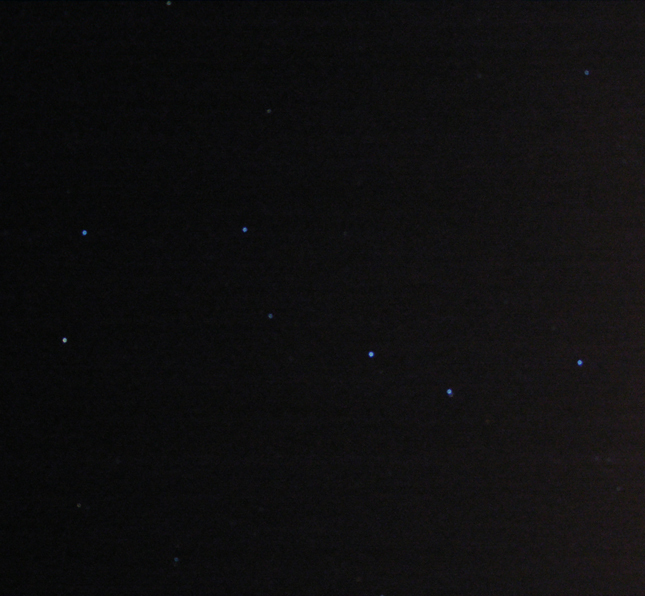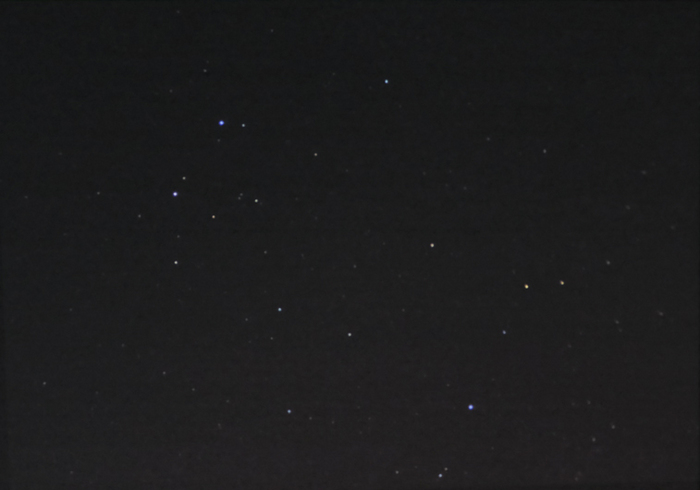Another clear night, must be a record ;o). Was quite surprised (not sure why though) as the forecast was for cloud. Tried to pop out early evening, was going to try a star trails photo. I checked, clear skies, popped into get the camera setup on the tripod (all of 2 minutes), popped back and guess what. Blinking clouds everywhere. I slink back indoors and put it all away again. Oh well thinks I, that'll be it then. I kept checking the satellite photos on the metoffice website and it look like it ought to be good. A couple of hours later, I checked, and yipee, no clouds. Now, I dashed around, adding layer upon layer (it was cold and I needed to) gathering my stuff together and out I went. Beautifully clear and cold. Excellent. I setup the camera for star trails. The usual self timer etc. about a minute later, it turned itself off. Damn it through I. Flat batteries (I hadn't changed them/recharged them) from a couple of nights before. Popped inside for some more, trying not to look at anything vaguely bright and using my red torch, nearly worked too. Plugged them into the camera, turned it on, and I don't believe it, they are flat also. Back for the third time. This time success. I got a fully charged set. Set it all up again. Waited for the self timer to count down, the usual message about pressing the shutter button to stop the exposure popped up, so I turned around to setup the scope. Looked back after a moment or two and the camera was off. That's odd I thought to myself and went to check. It turned on ok, no battery warning. Tried again. And again just over a minute later, it turned off. Checked the camera settings. It turns itself off after one minute. Blast. Checked the settings, maximum timout is 10 minutes. That's no good I'd hope to use the batteries up completely doing this. None of the previous attempts had captured anything, as when the camera turned off, it didn't save, only discarded. Ah well, gave up on that idea.
I finally got the scope up and running and had a look at M42 for a while, always a nice view. Moved up to belt and had a good long look at Collinder 70, then carried on up to Orion's head for Collinder 69 around Meissa. Decided I try again to find M41 and M50 had a look again at TL@O and this time guessed correctly the distance to shift the scope from Siruius.
A quick side note. After my efforts the other night, I sought some advice and was recommended to get a minus violet filter to remove the CA. This arrived Saturday morning and got a try out tonight. I used Sirius, as the moon was in hiding. Only when the scope was quite a way out of focus could I see evidence of purpe around the edges, so this filter seems to do it's job really well. Test's during the day, Saturday, showed a yellow hint to the view, but this wasn't noticeable looking at the stars.
Back to the night sky. Having guessed the correct distance, up popped M50. Had a look at this cluster. Then decided, that as my luck was in and I was on a roll to try again, and this time I got M41. Excellent, thought I and spent a while looking at this cluster also.
I moved onto Saturn, lurking around the side of the house. This time I didn't use such hgh magnification, which gave me a longer window of viewing before having to jiggle the photo tripod. I'm pretty certain that after a few minutes of viewing, that I saw a couple of Saturn's moons. One off to the left (or right or some direction, I get muddled by which direction is which in the ep) and one lower right. Even better than the previous session, and now I knew what to look for (others have been posting images) I may have seen a slight shadow around the ring system too.
I figured I'd have another go at a couple of constellations with the camera and opted for the Big Dipper and Gemini. I had intended to try for Cassiopeia, but by this time, she'd got a little low in the sky for my garden and was hiding in the upper branches of a tree.
Here's the images:
Big Dipper : 8x15 Seconds at ISO400
Gemini : 20x15 Seconds at ISO400
Whilst I was taking the Gemini images, I had a good look at Sirius and Beetlegeuse. Then moved onto M45 and watched this awhile (I like doing this, such a nice cluster). Whilst I was snapping away and looking at M45, a really odd thing happened, and it puzzled me for a while. I've understood that the more you look the more you see. So it was really odd to see the Pleiades dimming slowly. There was no sign of any fogging on my lenses, nor clouds up above. I took another few shots of Gemini whilst I pondered on this little conundrum. I'd noticed that it felt considerably colder than it had earlier in the evening. I decided to have a look round, and there was the reason. Rolling in from the west was a thick layer of fog, and I was in the outer edges. At that point I gave up and packed away. Spent a while warming up and allowing the lenses to unfog from being taken into the house, and whilst this was happening worked on stacking and processing the images.
Another enjoyable night under the stars. Looking forward to the next time the cloud pixies decide to give us a break, but looking at the window now as I write this, it doesn't look like it's going to be today.
Monday, 28 January 2008
Observing session 27th Jan
Subscribe to:
Post Comments (Atom)







No comments:
Post a Comment